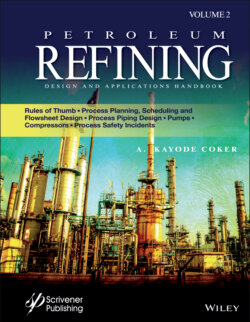Читать книгу Petroleum Refining Design and Applications Handbook - A. Kayode Coker - Страница 26
EXTRACTION, LIQUID–LIQUID
Оглавление1 1. The dispersed phase should be the one that has the higher volumetric rate, except in equipment subject to back-mixing where it should be the one with the smaller volumetric rate. It should be the phase that wets the material of construction less well. Since the holdup of continuous phase is greater, that phase should be made up of the less expensive or less hazardous material.
2 2. There are no known commercial applications of reflux to extraction processes, although the theory is favorable.
3 3. Mixer–settler arrangements are limited to at most five stages. Mixing is accomplished with rotating impellers or circulating pumps. Settlers are designed on the assumption that droplet sizes are about 150 µm in diameter. In open vessels, residence times of 30–60 min or superficial velocities of 0.15–0.46 m/min (0.5–1.5 ft/min) are provided in settlers. Extraction-stage efficiencies commonly are taken as 80%.
4 4. Spray towers as tall as 6–12 m (20–40 ft) cannot be depended on to function as more than a single stage.
5 5. Packed towers are employed when 5–10 stages suffice. Pall rings 25–38 mm (1–1.5 in.) in size are best. Dispersed-phase loadings should not exceed 10.2m3/min-m2 (25 gal./min-ft2), and HETS of 1.5–3.0 m (5–10 ft) may be realized. The dispersed phase must be redistributed every 1.5–2.1 m (5–7 ft). Packed towers are not satisfactory when the surface tension is more than 10 dyne/cm.
6 6. Sieve tray towers have holes of only 3–8 mm diameter. Velocities through the holes are kept below 0.24 m/s (0.8 ft/s) to avoid formation of small drops. Re-dispersion of either phase at each tray can be designed for. Tray spacings are 152–600 mm (6–24 in). Tray efficiencies are in the range of 20–30%.
7 7. Pulse packed and sieve tray towers may operate at frequencies of 90 cycles/min and amplitudes of 6–25 mm. In large-diameter tower, HETS of about 1 m has been observed. Surface tensions as high as 30–40 dyn/cm have no adverse effect.
8 8. Reciprocating tray towers can have holes of 150 mm (9/16 in.) diameter, 50–60% open area, stroke length 190 mm (0.75 in.), 100–150 strokes/min, and plate spacing normally 50 mm (2 in.) but in the range of 25.0–150 mm (1–6 in.). In a 760-mm (30-in.) diameter tower, HETS is 500–650 mm (20–25 in.) and throughput is 13.7 m3/min-m2 (2000 gal./h-ft2). Power requirements are much less than those of pulsed towers.
9 9. Rotating disk contractors or other rotary agitated towers realize HETS in the range of 0.1–0.5 m (0.33–1.64 ft). The especially efficient Kuhni with perforated disks of 40% free cross section has HETS of 0.2 m (0.66 ft) and a capacity of 50 m3 /m2-h (164 ft3/ft2-h).
